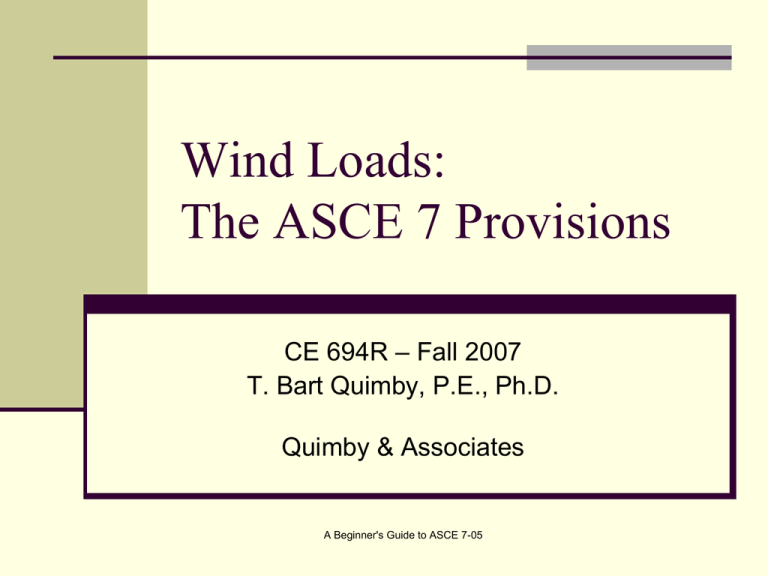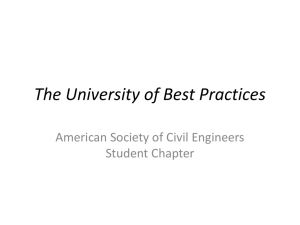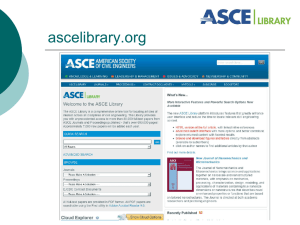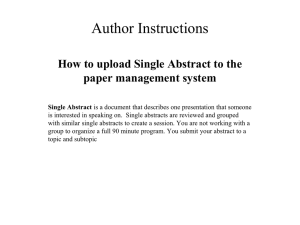Wind Provisions - A Beginner`s Guide to Structural Engineering
advertisement

Wind Loads: The ASCE 7 Provisions CE 694R – Fall 2007 T. Bart Quimby, P.E., Ph.D. Quimby & Associates A Beginner's Guide to ASCE 7-05 Permitted Design Methods See ASCE 7-05 6.1.2 Method 1—Simplified Procedure (ASCE 7-05 Section 6.4) Low rise buildings. This is an outgrowth of work done for/by the metal building industry. Method 2—Analytical Procedure (ASCE 7-05 Section 6.5) The typically used procedure. This is the main focus of this presentation. Method 3—Wind Tunnel Procedure (ASCE 7-05 6.6) A Beginner's Guide to ASCE 7-05 Important Definitions See ASCE 7-05 6.2 Basic Wind Speed Building open, enclosed, partially enclosed Low-Rise Building A Beginner's Guide to ASCE 7-05 Exposure Categories See ASCE 7-05 6.5.6 & C6.5.6 (See images!) Exposure A – Deleted in ASCE 7-02 and later Extremely sheltered. Large city centers with tall buildings. Exposure B Urban and suburban areas, wooded areas, areas with many closely spaced obstructions. Exposure C Open terrain with scatter obstructions. Airports, areas that are generally flat open country. Exposure D Flat, unobstructed areas and water surfaces outside hurricane prone regions. This category includes smooth mud flats, salt flats, and unbroken ice that extend 5,000 ft or 20 times the building height in the upwind direction. A Beginner's Guide to ASCE 7-05 Determining Exposure Wind Direction & Sectors (ASCE 7-05 6.5.6.1) the exposure of the building or structure shall be determined for the two upwind sectors extending 45o either side of the selected wind direction. the exposure resulting in the highest wind loads shall be used to represent the winds from that direction. A Beginner's Guide to ASCE 7-05 ASCE 7-05 Wind Pressures The basic form of the pressure equation: p = qGC Where p = a wind pressure on a surface q = velocity pressure. This is the pressure due to a moving fluid on a flat plate G = gust factor. The gust factor accounts for dynamic interaction between the flowing air and the structure C = pressure coefficient. The pressure coefficient accounts for varying pressure across a surface. A Beginner's Guide to ASCE 7-05 Velocity Pressure, q See ASCE 7-05 6.5.10 qz =Velocity Pressure = 0.00256KzKzt KdV2 I (lb/ft2) Constant 0.00256 V = Basic wind speed in mph I = Importance Factor (i.e. different MRI) Kz = Exposure Coefficient Kzt = Topographical Factor Kd = Wind Directionality Factor Evaluated at an elevation z: qz = 0.00256V2IKzKztKd Evaluated at the building mean roof elevation, h: qh = 0.00256V2I KhKhtKd A Beginner's Guide to ASCE 7-05 The Velocity Coefficient See ASCE 7-05 C6.5.10 Based on the average density of air at sea level. 1 5280 2 2 2 1 0.0765 P V [ ][ ] V 0.00256V 2 2 2 32.2 3600 A Beginner's Guide to ASCE 7-05 Basic Wind Speed, V See ASCE 7-05 6.5.4 Obtained from Wind Speed maps in ASCE 7- 05 Figure 6-1. Determined by localized research using approved probabilistic methods. “The basic wind speed shall be increased where records or experience indicate that the wind speeds are higher than those reflected in Fig. 6-1.” (ASCE 7-05 6.5.4.1) A Beginner's Guide to ASCE 7-05 The Importance Factor, I See ASCE 7-05 6.5.5, Table 6-1 and Commentary 6.5.5 Category I: I = .87 MRI is 25 years Category II: I = 1.00 MRI is 50 years Category III & IV: I = 1.15 MRI is 100 years Building Categories are listed in ASCE 7-05 Table 1-1. A Beginner's Guide to ASCE 7-05 Velocity Pressure Exposure Coefficients, Kz and Kh See ASCE 7-05 6.5.6.6, Tables 6-2 and 6-3, and C6.5.6.6 Modifies basic wind pressure for heights other than 33 ft and exposures other than exposure C. Can compute K directly from equations in the commentary for any height and/or exposure. Good for spreadsheet or computer programming. For elevations less than 15 ft, use K15. For elevations above gradient height use Kg. A Beginner's Guide to ASCE 7-05 Kz & Kh Computation Kz = 2.01(z/zg)2/a When z > zg use z = zg When z < 15 use z = 15 ft K Com putation 2.50 2.00 Exposure B K 1.50 Exposure C 1.00 Exposure D 0.50 0.00 0 500 1000 Elevation, z (ft) A Beginner's Guide to ASCE 7-05 1500 2000 Topographical Factor, Kzt See ASCE 7-05 6.5.7 & Commentary 6.5.7 Kzt = 1.0 when: H/Lh < 0.2, or H < 15' for Exposures C & D, or H < 60' for Exposure B. Kzt = (1+K1K2K3)2 A Beginner's Guide to ASCE 7-05 Kzt Constants A Beginner's Guide to ASCE 7-05 Kzt Multipliers by Equation See ASCE 7-05 Figure 6.4 A Beginner's Guide to ASCE 7-05 Directionality Factor, Kd See ASCE 7-05 6.5.4.4 and Table 6-4 This factor shall only be applied when used in conjunction with load combinations specified in Sections 2.3 and 2.4. The wind load factors changed when the directionality factor was extracted. A Beginner's Guide to ASCE 7-05 The Gust Factor, G Factor accounting for: Gustiness and turbulence Gust frequency Gust size Integral scale longitudinal and lateral Frequency of structure Structural damping Aerodynamic admittance Gust correlation A Beginner's Guide to ASCE 7-05 Gust Factor, G See ASCE 7-05 6.5.8 For stiff buildings and stiff structures G = 0.85 For flexible buildings and other structures Calculate “by a rational analysis that incorporates the dynamic properties of the main wind-force resisting system.” A Beginner's Guide to ASCE 7-05 Pressure Coefficients, C The pressure coefficients are based on The enclosure category of the structure The location on a structure for which a pressure is to be computed. The pressure coefficients have been determined experimentally from wind tunnel studies done on regular shaped structures The coefficient represents the ratio between measured pressure and the computed basic velocity pressure. C P measured 1 V 2 2 A Beginner's Guide to ASCE 7-05 Enclosure Classifications See ASCE 7-05 6.2 & 6.5.9 A building is to be classified as one of the following: Open Ao > 0.8Ag for each wall Partially Enclosed Ao > 1.10 Aoi, and Ao > min[4 sqft , 0.01Ag], and Aoi/Agi < 0.20 Enclosed A building that is neither open nor partially enclosed. A Beginner's Guide to ASCE 7-05 Location of Pressure ASCE 7 provides means for computing forces on various surfaces. The building envelope surfaces experience pressure on both sides (i.e. external and internal). A Beginner's Guide to ASCE 7-05 Internal Pressure Coefficients, GCpi See ASCE 7-05 6.5.11.1 & Figure 6-5 Internal pressure is fairly easy because the air is relatively stagnant and the shape of the structure does not affect it’s magnitude. As gusting is not a concern internally, the gust factor and the pressure coefficient are combined. GCpi The magnitude of the internal pressure coefficient is strictly dependent on the enclosure classification. The pressure can be both positive or negative (i.e. suction) depending on the direction of the wind relative to opening for partially enclosed or enclosed buildings. Both internal pressures must be considered. A Beginner's Guide to ASCE 7-05 Internal Pressure A Beginner's Guide to ASCE 7-05 External Pressure Coefficients, Cp See ASCE 7-05 6.5.11.2 & Figures 6-6, 6-7, and 6-8 As external surfaces are subject to “flowing” air, the pressure varies considerably on the building surface depending on structural configuration and direction of the wind. Coefficients also depend on whether the resulting forces are to be used to design/analyze: Main Wind-Force Resisting Systems Structural elements that support large areas exposed to the wind Components & Cladding Structural elements that support small areas exposed to the wind A Beginner's Guide to ASCE 7-05 Buildings with Roofs Consisting of Flat Surfaces See ASCE 7-05 Figure 6-6 ASCE 7-05 Figure 6-6 gives the external coefficients of wall and roof surfaces. A Beginner's Guide to ASCE 7-05 Buildings with Roofs Consisting of Flat Surfaces – Wall Cp See ASCE 7-05 Figure 6-6 Wall pressure depends on whether the wall is Windward Leeward Same regardless of building plan dimensions Dependant on building plan dimensions Side Same regardless of building plan dimensions A Beginner's Guide to ASCE 7-05 Buildings with Roofs Consisting of Flat Surfaces – Roof Cp See ASCE 7-05 Figure 6-6 Dependent on direction of wind relative to ridge Coefficients are given for various conditions. Interpolation is used to find values of conditions between those given. A Beginner's Guide to ASCE 7-05 Wind Normal to Ridge See ASCE 7-05 Figure 6-6 Wind NORMAL to ridge Values given for different building height to length ratios and roof slope angles. Windward roof surfaces Can be both positive and negative on some slopes. Both need consideration as separate load cases. Leeward roof surfaces All negative. A Beginner's Guide to ASCE 7-05 Wind Parallel to Ridge See ASCE 7-05 Figure 6-6 Parallel to ridge, flat or nearly flat Two different h/L ranges, both with stepped pressures. Interpolate between ranges A Beginner's Guide to ASCE 7-05 Domed Roofs See ASCE 7-05 Figure 6-7 Pressure distributions are fairly complex. Two load cases to be considered. A Beginner's Guide to ASCE 7-05 Arched Roofs See ASCE 7-05 Figure 6-8 Pressure coefficient depends on rate of rise of the arch. Pressure varies by along the arch. A Beginner's Guide to ASCE 7-05 Components & Cladding Elements of the structure that support local peak loads need to be designed for these pressures. The magnitude of the force is dependent on the wind area tributary to the component The smaller the tributary area of a component the more likely to see relatively high pressures on their tributary areas. A Beginner's Guide to ASCE 7-05 Some Local Effects Wind around a corner A Beginner's Guide to ASCE 7-05 Image from FEMA Multi Hazard Seminar Wind at a Corner A Beginner's Guide to ASCE 7-05 Image from FEMA Multi Hazard Seminar Uplift on Roof Images from FEMA Multi Hazard Seminar A Beginner's Guide to ASCE 7-05 Wall Components See ASCE 7-05 Figure 6-11A For buildings under 60 ft See ASCE 7-05 Figure 6-17 for building greater than 60 ft tall. A Beginner's Guide to ASCE 7-05 Roof Components Lots of different roof types with different requirements. Gable Roofs of various angles Gable/Hip Roofs Stepped Roofs Multispan Gable Roofs Monoslope Roofs Sawtooth Roofs A Beginner's Guide to ASCE 7-05 Typical Roof Chart A Beginner's Guide to ASCE 7-05 Finding Net Pressure See ASCE 7-05 6.5.12 The net pressure is the vector sum of the internal and external pressures. Typical form: p = qGCp – qi(GCpi) Note the sign… positive pressure externally opposes positive pressure internally (i.e. they act in opposite directions). A Beginner's Guide to ASCE 7-05 Sample Problem V = 120 mph Exposure C Enclosed A Beginner's Guide to ASCE 7-05





